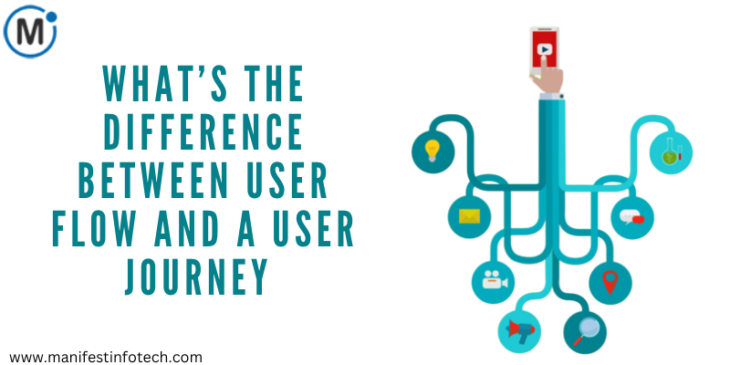
In this blog post, we’ll delve into the differences between user flow and user journey in UX design, exploring their definitions, purposes, and key characteristics.
𝐔𝐬𝐞𝐫 𝐅𝐥𝐨𝐰:
User flow refers to the visual representation of the steps a user takes to accomplish a specific task within a digital product or service. It outlines the sequence of actions, decisions, and interactions that users go through from the initial entry point to the completion of their goal. User flows typically depict the navigation paths, screen transitions, and decision points encountered by users as they move through the interface. They are often depicted using flowcharts, diagrams, or wireframes and are used to identify potential bottlenecks, optimize navigation, and ensure a seamless user experience.
𝐊𝐞𝐲 𝐂𝐡𝐚𝐫𝐚𝐜𝐭𝐞𝐫𝐢𝐬𝐭𝐢𝐜𝐬 𝐨𝐟 𝐔𝐬𝐞𝐫 𝐅𝐥𝐨𝐰:
𝟏. 𝐒𝐞𝐪𝐮𝐞𝐧𝐭𝐢𝐚𝐥 𝐑𝐞𝐩𝐫𝐞𝐬𝐞𝐧𝐭𝐚𝐭𝐢𝐨𝐧: User flows present a linear sequence of steps, illustrating the order in which users navigate through the interface to achieve their goals.
𝟐. 𝐓𝐚𝐬𝐤-𝐂𝐞𝐧𝐭𝐫𝐢𝐜 𝐅𝐨𝐜𝐮𝐬:User flows focus on specific tasks or user goals, such as completing a purchase, signing up for an account, or accessing content.
𝟑. 𝐈𝐧𝐭𝐞𝐫𝐚𝐜𝐭𝐢𝐨𝐧 𝐌𝐚𝐩𝐩𝐢𝐧𝐠: User flows map out the interactions between users and the interface, including actions, inputs, and feedback mechanisms.
𝟒. 𝐆𝐫𝐚𝐧𝐮𝐥𝐚𝐫 𝐃𝐞𝐭𝐚𝐢𝐥: User flows often include detailed descriptions of each step, including user actions, system responses, and potential error states.
𝐔𝐬𝐞𝐫 𝐉𝐨𝐮𝐫𝐧𝐞𝐲:
User journey, on the other hand, refers to the holistic view of the user’s overall experience with a product or service over time. It encompasses the entire lifecycle of the user’s interaction, from their initial awareness and discovery of the product to their ongoing engagement, usage, and eventual conversion or churn. User journeys take into account the various touchpoints, channels, and interactions users have with the product across different devices, platforms, and contexts. They provide insights into user motivations, needs, emotions, and pain points throughout their journey and are used to inform UX design decisions, product strategy, and marketing efforts.
𝐊𝐞𝐲 𝐂𝐡𝐚𝐫𝐚𝐜𝐭𝐞𝐫𝐢𝐬𝐭𝐢𝐜𝐬 𝐨𝐟 𝐔𝐬𝐞𝐫 𝐉𝐨𝐮𝐫𝐧𝐞𝐲:
𝟏. 𝐍𝐨𝐧-𝐋𝐢𝐧𝐞𝐚𝐫 𝐑𝐞𝐩𝐫𝐞𝐬𝐞𝐧𝐭𝐚𝐭𝐢𝐨𝐧: Unlike user flows, user journeys are non-linear and can involve multiple touchpoints, channels, and interactions that occur over time.
𝟐. 𝐂𝐨𝐧𝐭𝐞𝐱𝐭𝐮𝐚𝐥 𝐔𝐧𝐝𝐞𝐫𝐬𝐭𝐚𝐧𝐝𝐢𝐧𝐠: User journeys consider the broader context in which users engage with the product, including their motivations, goals, behaviors, and environmental factors.
𝟑. 𝐄𝐦𝐨𝐭𝐢𝐨𝐧-𝐂𝐞𝐧𝐭𝐫𝐢𝐜 𝐀𝐩𝐩𝐫𝐨𝐚𝐜𝐡: User journeys focus on understanding the emotional highs and lows users experience throughout their interaction with the product, such as frustration, satisfaction, delight, and loyalty.
𝟒. 𝐋𝐢𝐟𝐞𝐜𝐲𝐜𝐥𝐞 𝐏𝐞𝐫𝐬𝐩𝐞𝐜𝐭𝐢𝐯𝐞:User journeys span the entire user lifecycle, from initial discovery and onboarding to ongoing engagement, retention, and loyalty-building efforts.
If you are looking for any services related to Website Development, App Development, Digital Marketing and SEO, just email us at nchouksey@manifestinfotech.com or Skype id: live:76bad32bff24d30d
𝐅𝐨𝐥𝐥𝐨𝐰 𝐔𝐬:
𝐋𝐢𝐧𝐤𝐞𝐝𝐢𝐧: linkedin.com/company/manifestinfotech
𝐅𝐚𝐜𝐞𝐛𝐨𝐨𝐤: facebook.com/manifestinfotech/
𝐈𝐧𝐬𝐭𝐚𝐠𝐫𝐚𝐦: instagram.com/manifestinfotech/
𝐓𝐰𝐢𝐭𝐭𝐞𝐫: twitter.com/Manifest_info
#UserFlow #UserJourney #UXDesign #UIUX #UXProcess #DesignThinking #UXStrategy #UserExperience #DigitalDesign #UXResearch #UserInteraction #InformationArchitecture #DesignPrinciples #UXAnalysis #UXPatterns #DesignEducation #UXCommunity #UXTips #UXConcepts #UXDifferences